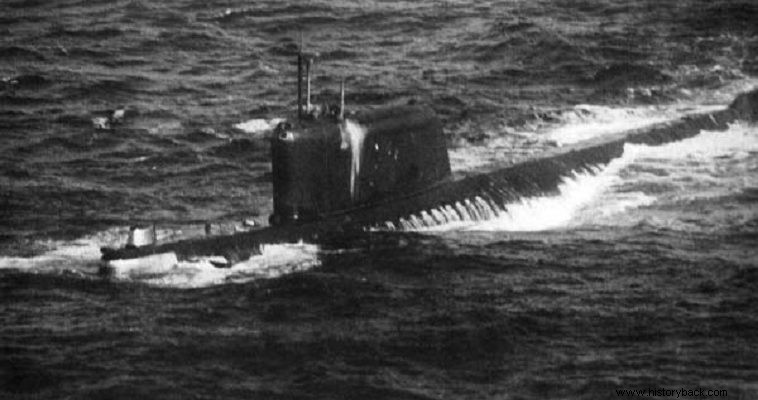
The Soviet Navy began building its first ballistic missile submarine capable of carrying nuclear warheads in 1958. The vessel was launched on October 17 and was to write one of the blackest pages in the history of the Russian-Soviet Navy. /em>
The vessel was the first of the 658 class (NATO code Hotel I). Inducted in 1959 and entered service in 1960. It had a displacement of 5,500 tons, a length of 114m, a width of 9.2m, a crew of 104 men and was powered by two nuclear reactors.
It developed a maximum surface speed of 18 knots and a dive of 26 knots. Carried three R-13 ballistic missiles (NATO code SS-N-4 Shark) mounted vertically on the rear of the submarine's turret, which had a range of approximately 650 km.
The vessel also carried four 21in and four 16in torpedo tubes. It could, theoretically, dive to a depth of up to 300m. However, in order to launch its missiles, it had to emerge, requiring about 12 minutes of preparation time, after emergence, for the shot.
The boat was not of good construction as the Soviets rushed to build a fleet of ballistic missile submarines as a counterweight to American supremacy. The captain of the K-19 himself, Nikolai Zatayev, did not consider his vessel fit for service.
A grizzled death machine...
After all, the boat carried the reputation of the "Grousuziko" already from its launch, as the bottle of champagne that was thrown on it during the "baptism" did not break. The craft confirmed its reputation when, while loading the rockets, a worker was literally crushed by the watertight door of the launch compartment. Two other workers were burned alive in a fire that broke out during its construction, and six more workers died from fumes while gluing sealant!
As if all this were not enough, in January 1960, during tests, due to crew error, a nuclear reactor failed. During the sea trials, after a rapid ascent, the outer coating of the boat completely disappeared, while in a dive at a depth of 300m. water inflow occurred in the reactor compartment.
Zatayev immediately ordered a launch, and the boat, tilting from the water it had taken on, limped into port. As it was discovered it was a manufacturing fault. A new accident occurred in October in the boat's galley, with the result that the ninth compartment of the boat again took on water and was flooded by 2/3. Miraculously there were no human casualties. In December 1960 the cooling system developed a problem.
Nevertheless, on June 18, 1961, the walking death set sail for his first mission with 139 men, as specialists were added to his crew.
Leakage of radioactivity
On July 4, while the vessel was in the North Atlantic, it developed a radioactive leak. The cause of the leak is believed to be a mistake during the tests of a reactor, when the pressure in it increased to 400 atmospheres when their endurance limit was only 200.
Her manager realized the problem at the time, but didn't tell anyone, possibly out of fear for his personal safety... The leak came from the pressure regulator in the reactor's main cooling system, causing a sudden drop in pressure that shut down the auxiliary system as well.
So the water used to cool the reactors began to boil with the temperature in the compartment of one reactor reaching 800 degrees Celsius . A fire soon broke out. The fire was extinguished but the problem remained.
Captain Zatayev, however, did not react immediately. When he realized what had happened his options were limited. The leak had to be stopped and to do this crew members had to enter the reactor compartment.
This was the only way to avoid blowing up the submarine. But it was a given that those entering the reactor compartment had no hope of survival. Eventually eight heroes were found and managed to solve the problem using the submarine's supply of drinking water. But they were exposed to very strong doses of radioactivity. Eventually a conventional submarine sailed close by and rounded up the crew as the K-19 refused offered American assistance. And the K-19 was towed to its base.
Deaths to the end
Within days the eight were dead. But other crew members were also exposed to the radiation and 15 died within the next two years. Also infected were men from the repair shops who carried out the repair work which also lasted two years.
Nevertheless, the submarine was repaired and even upgraded to Hotel II level. However, the misfortune continued. In 1969 the submarine collided, inside the seabed, with the American submarine USS Gato just saved . In 1972, however, an even greater disaster befell the boat, in which a fire broke out. Some sources say that the cause of the disaster was not the fire but a new leak of radioactivity.
Anyway 30 crew members died. Despite the fact that the Soviet authorities kept secret everything that happened in K-19 anyway – only after the collapse of the USSR was the truth learned – they simply ordered the vessel repaired and returned to active service.
Pravda, in 1991, wrote that the 1972 accident was also caused by a radioactive leak. The vessel was decommissioned only in 1990. It was not by chance that its crew named it Hiroshima. Another "diminutive" of his was not "the machine that creates widows...".
